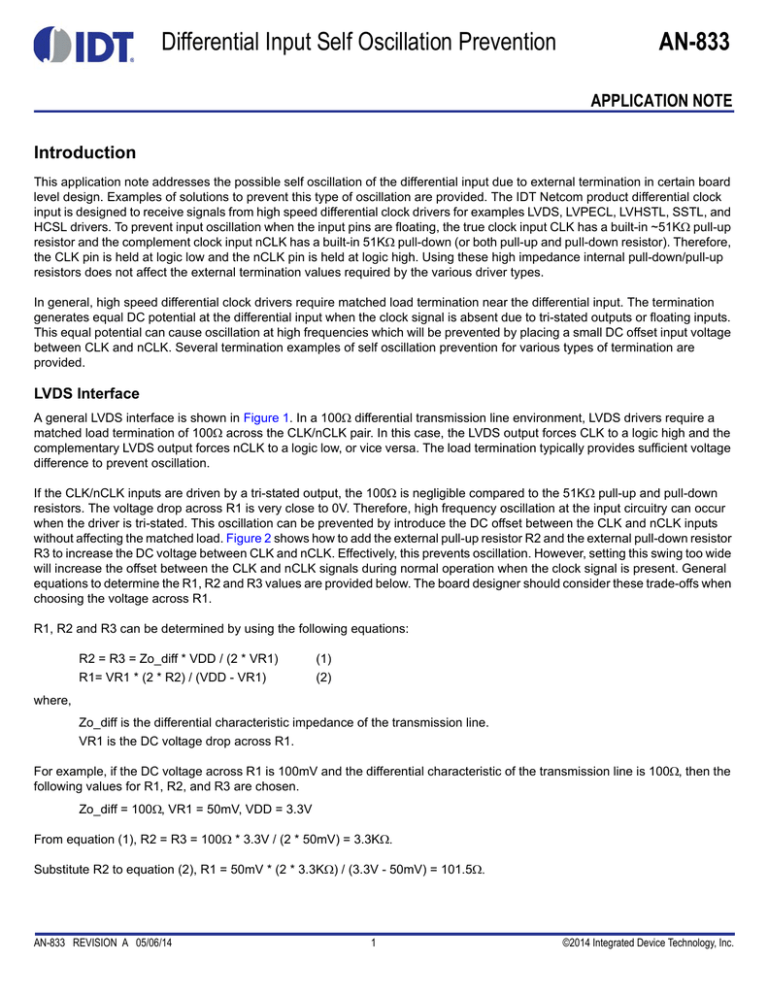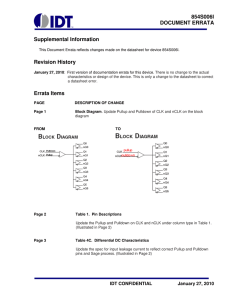
Differential Input Self Oscillation Prevention
AN-833
APPLICATION NOTE
Introduction
This application note addresses the possible self oscillation of the differential input due to external termination in certain board
level design. Examples of solutions to prevent this type of oscillation are provided. The IDT Netcom product differential clock
input is designed to receive signals from high speed differential clock drivers for examples LVDS, LVPECL, LVHSTL, SSTL, and
HCSL drivers. To prevent input oscillation when the input pins are floating, the true clock input CLK has a built-in ~51K pull-up
resistor and the complement clock input nCLK has a built-in 51K pull-down (or both pull-up and pull-down resistor). Therefore,
the CLK pin is held at logic low and the nCLK pin is held at logic high. Using these high impedance internal pull-down/pull-up
resistors does not affect the external termination values required by the various driver types.
In general, high speed differential clock drivers require matched load termination near the differential input. The termination
generates equal DC potential at the differential input when the clock signal is absent due to tri-stated outputs or floating inputs.
This equal potential can cause oscillation at high frequencies which will be prevented by placing a small DC offset input voltage
between CLK and nCLK. Several termination examples of self oscillation prevention for various types of termination are
provided.
LVDS Interface
A general LVDS interface is shown in Figure 1. In a 100 differential transmission line environment, LVDS drivers require a
matched load termination of 100 across the CLK/nCLK pair. In this case, the LVDS output forces CLK to a logic high and the
complementary LVDS output forces nCLK to a logic low, or vice versa. The load termination typically provides sufficient voltage
difference to prevent oscillation.
If the CLK/nCLK inputs are driven by a tri-stated output, the 100 is negligible compared to the 51K pull-up and pull-down
resistors. The voltage drop across R1 is very close to 0V. Therefore, high frequency oscillation at the input circuitry can occur
when the driver is tri-stated. This oscillation can be prevented by introduce the DC offset between the CLK and nCLK inputs
without affecting the matched load. Figure 2 shows how to add the external pull-up resistor R2 and the external pull-down resistor
R3 to increase the DC voltage between CLK and nCLK. Effectively, this prevents oscillation. However, setting this swing too wide
will increase the offset between the CLK and nCLK signals during normal operation when the clock signal is present. General
equations to determine the R1, R2 and R3 values are provided below. The board designer should consider these trade-offs when
choosing the voltage across R1.
R1, R2 and R3 can be determined by using the following equations:
R2 = R3 = Zo_diff * VDD / (2 * VR1)
(1)
R1= VR1 * (2 * R2) / (VDD - VR1)
(2)
where,
Zo_diff is the differential characteristic impedance of the transmission line.
VR1 is the DC voltage drop across R1.
For example, if the DC voltage across R1 is 100mV and the differential characteristic of the transmission line is 100, then the
following values for R1, R2, and R3 are chosen.
Zo_diff = 100, VR1 = 50mV, VDD = 3.3V
From equation (1), R2 = R3 = 100 * 3.3V / (2 * 50mV) = 3.3K
Substitute R2 to equation (2), R1 = 50mV * (2 * 3.3K) / (3.3V - 50mV) = 101.5
AN-833 REVISION A 05/06/14
1
©2014 Integrated Device Technology, Inc.
AN-833
Figure 1. General LVDS to Differential Input Interface
3.3V
100 Ohm Differential Trans miss ion Line
3.3V
CLK
R1
nCLK
LVDS Driver
Figure 2. LVDS Driver with Tri-state to Differential Input Interface. Add small DC offset between CLK and
nCLK to prevent oscillation.
3.3V
100 Ohm Differential Trans miss ion Line
R2
3.3V
CLK
R1
nCLK
LVDS Driver wit h tri-state
R3
LVPECL Interface
A general 3.3V LVPECL driver to differential input interface is shown in Figure 3. In a 50 single ended or 100 differential
transmission line environment, LVPECL drivers require a matched load termination of 50 to VCC-2V = 1.3V for each output.
In this case, the LVPECL driver output forces CLK to logic high and the complementary LVPECL output forces nCLK to logic low
or vice versa. The CLK and nCLK typically have sufficient potential difference to prevent oscillation.
For the CLK/nCLK inputs driven by a tri-state output, the bias resistor will generate the same potential of 1.3V at both CLK and
nCLK pins. The voltage between CLK and nCLK is very close to 0V. As a result, high frequency oscillation at the input circuitry
can occur when the driver is tri-stated. This oscillation will be prevented by placing a minimum peak-to-peak input voltage
between the CLK and nCLK inputs which does not affect the matched load. Figure 4 shows the method for changing the bias
resistor values at the CLK input. General equations to determine the R3 and R1 values are provided below. Effectively, this
prevents oscillation. However, setting this swing too wide will increase the offset between the CLK and nCLK signals. The board
designer should consider these trade-offs when choosing the voltage between CLK and nCLK.
R1 and R3 can be determined by using the following equations:
R3 = Zo * VDD / (VDD - 2 - Voffset)
(3)
R1 = R3 * Zo / (R3 - Zo)
(4)
where,
DIFFERENTIAL INPUT SELF OSCILLATION PREVENTION
2
REVISION A 05/06/14
AN-833
Zo is characteristic impedance of the transmission line.
Voffset is the DC voltage between CLK and nCLK.
For example, if the DC voltage between CLK and nCLK is set to 100mV and the characteristic impedance of the transmission
line is 50, then the values for R3 and R1 are as follows:
R3 = 50 * 3.3V / (3.3V - 2V - 100mV) = 137
R1 = 50 * 137 / (137 - 50) = 78
Figure 5 shows general termination for an LVPECL driver with AC coupling. When the clock signal is absent, the bias resistors
R1, R2, R3 and R4 will create an equal DC potential for the CLK and nCLK input pair. To prevent oscillation, the small offset
described above can be introduced by using equations (3) and (4). An example is shown in Figure 6.
Figure 3. General LVPECL to Differential Input Interface
3.3V
R3
125
3.3V
R4
125
50 Ohm
CLK
50 Ohm
nCLK
LVPECL
R1
84
R2
84
Figure 4. LVPECL Driver with Tri-state to Differential Input Interface. Add a small offset between CLK and
nCLK to prevent oscillation.
3.3V
R3
137
3.3V
R4
125
50 Ohm
CLK
50 Ohm
nCLK
LVPECL
REVISION A 05/06/14
R1
78
3
R2
84
DIFFERENTIAL INPUT SELF OSCILLATION PREVENTION
AN-833
Figure 5. General LVPECL Driver with AC couple to Differential Input Interface
3.3V
R3
125
3. 3V
LVPECL
R4
125
C1
50 Ohm
CLK
50 Ohm
nC LK
C2
R5
100 - 200
R6
100 - 200
R1
84
R2
84
Figure 6. LVPECL Driver AC couple to Differential Input Interface with a small offset at the CLK and nCLK
to prevent oscillation.
3.3V
R3
137
3. 3V
LVPECL
R4
125
C1
50 Ohm
CLK
50 Ohm
nC LK
C2
R5
100 - 200
R6
100 - 200
R1
78
R2
84
LVHSTL Interface
Figure 7 and Figure 8 show general and AC coupled terminations for an open source LVHSTL interface. Typically, open source
LVHSTL drivers do not have tri-state capability. The driver will force one side high and the other side low during reset. If the clock
signal is absent for the interface with AC coupling (as shown in Figure 8), oscillation may occur. A small offset between the CLK
and nCLK pair can be introduced using equations (3) and (4). An example of this interface is shown in Figure 9.
DIFFERENTIAL INPUT SELF OSCILLATION PREVENTION
4
REVISION A 05/06/14
AN-833
Figure 7. General LVHSTL to Differential Input Interface
3.3V
1.8V
LVHSTL
Zo = 50 ohm
CLK
Zo = 50 ohm
nCLK
R1
50
R2
50
Figure 8. General LVHSTL Driver to Differential Input Interface with AC Coupling
REVISION A 05/06/14
5
DIFFERENTIAL INPUT SELF OSCILLATION PREVENTION
AN-833
Figure 9. LVHSTL Driver AC coupled to Differential Input Interface with a small DC offset between the CLK
and nCLK to prevent oscillation.
Conclusion
The application note shows how the introduction of a small DC offset voltage between CLK and nCLK was used to prevent
oscillation when the input clock signal is absent and the input is floating. Wider DC offset input voltage provides more margin to
prevent oscillation. However, setting this DC offset too wide will increase the offset between the true and complementary input
signals during normal operation. Board designers should consider these trade-offs when choosing the DC offset voltage.
DIFFERENTIAL INPUT SELF OSCILLATION PREVENTION
6
REVISION A 05/06/14
Corporate Headquarters
Sales
Tech Support
6024 Silver Creek Valley Road
San Jose, CA 95138 USA
1-800-345-7015 or 408-284-8200
Fax: 408-284-2775
www.IDT.com
email: clocks@idt.com
DISCLAIMER Integrated Device Technology, Inc. (IDT) and its subsidiaries reserve the right to modify the products and/or specifications described herein at any time and at IDT’s sole discretion. All information in
this document, including descriptions of product features and performance, is subject to change without notice. Performance specifications and the operating parameters of the described products are determined
in the independent state and are not guaranteed to perform the same way when installed in customer products. The information contained herein is provided without representation or warranty of any kind, whether
express or implied, including, but not limited to, the suitability of IDT’s products for any particular purpose, an implied warranty of merchantability, or non-infringement of the intellectual property rights of others. This
document is presented only as a guide and does not convey any license under intellectual property rights of IDT or any third parties.
IDT’s products are not intended for use in applications involving extreme environmental conditions or in life support systems or similar devices where the failure or malfunction of an IDT product can be reasonably
expected to significantly affect the health or safety of users. Anyone using an IDT product in such a manner does so at their own risk, absent an express, written agreement by IDT.
Integrated Device Technology, IDT and the IDT logo are registered trademarks of IDT. Product specification subject to change without notice. Other trademarks and service marks used herein, including protected
names, logos and designs, are the property of IDT or their respective third party owners.
Copyright ©2014 Integrated Device Technology, Inc.. All rights reserved.




